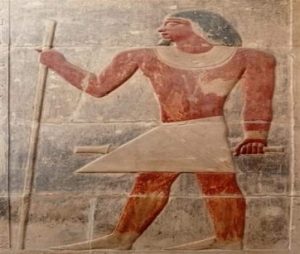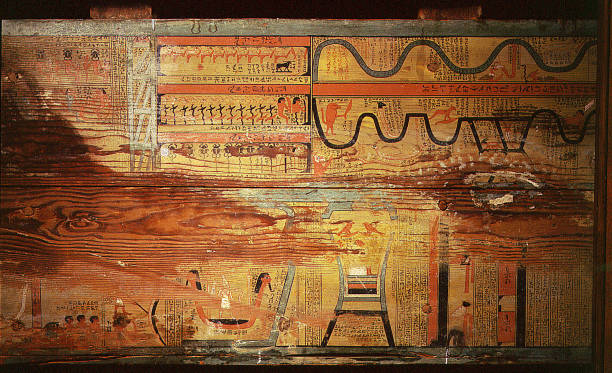Coffin Texts
As previously mentioned, one of the most distinctive religious features of the Early Intermediate Period was the emergence of Coffin Texts. Unlike the Pyramid Texts, which were exclusively reserved for pharaohs, during the Early Intermediate Period, these texts began to be inscribed on the coffins of ordinary people and provincial governors. – A wooden coffin of the minister “Nekhti” from the Twelfth Dynasty. It was discovered in Asyut and is now preserved in the Louvre Museum in Paris
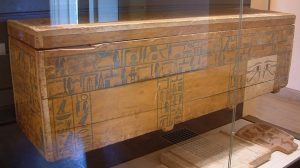
The Middle Kingdom (2055/1650 B.C)
King (Mentuhotep Neb-hepet-ra) reunited the land once more, and built himself a tomb in West Thebes and a temple next to Hatshepsut’s temple, which Carter discovered in 1908. He restored centralized rule after battling the rulers of Herakleopolis to achieve this unification and ruled the country from Thebes, founding the Eleventh Dynasty.
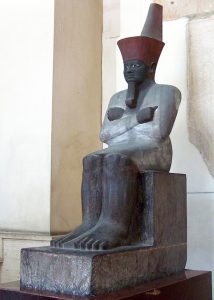
A relief depicting King Mentuhotep Ra, from his mortuary temple at EL Deir el-Bahri
colored sandstone statue of King Mentuhotep Ra (founder of the Middle Kingdom) is housed in the Egyptian Museum.
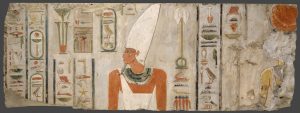
Scenes of the king’s wife
Among the most beautiful scenes from his era are the coffin texts on the coffin of Queen “Kawit”, wife of Mentuhotep Ra. On the exterior of the coffin, daily life scenes were engraved. On one side, the queen is depicted drinking, with a table full of food in front of her, while a servant adjusts her wig, and another servant pours her a drink. In her other hand, the queen holds a mirror. On the other side, the queen is depicted holding a lotus flower in front of her nose while dipping her finger in a container of ointment held by a servant. In front of her is her jewelry box, with a depiction of the jewelry inside. Other scenes, such as milking cows, were also engraved. The combination of beauty seen in the depiction of jewelry, mirrors, and ointments, along with lotus flowers, cows, and milk, forms a clear symbolism of fertility, youth, birth, and Hathor, the goddess of love, beauty, fertility, music, and motherhood. -Scenes from the sarcophagus of Queen Kawit, wife of Mentuhotep Ra

Made of limestone, it was found at El Deir el-Bahri and is now housed in the Egyptian Museum in Tahrir.
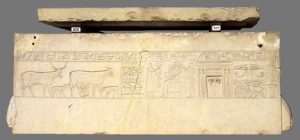
The 12th Dynasty
At the end of the 11th Dynasty and after the death of its last king, Mentuhotep IV, his minister “Amenemhat I” assumed the throne but established a new capital for the country in the Fayoum.
King Senusret III
One of the most important kings of the Middle Kingdom. He was interested in campaigns in Nubia, built many forts and castles there, and re-dug a canal in Upper Nubia. -The head of a statue of King Senusret III in the Luxor Museum for Ancient Egyptian Art, made of pink granite
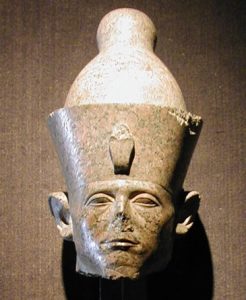
Queen Sobek neferu
She was the daughter of King Amenemhat III, the sister and wife of King Amenemhat IV. After the death of her husband, King Amenemhat IV, the Egyptian state weakened, and the queen assumed the throne for three years. She adopted the titles of a king ruling over the land rather than those of a queen. The cause of her death remains unknown. It is widely known that her death marked the end of the Middle Kingdom and the beginning of the Second Intermediate Period, characterized by the decentralization of power and the return of regional governors to rule.
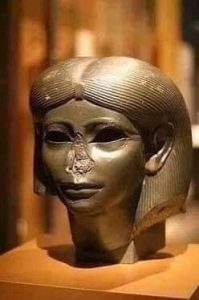
Literature in the Middle Kingdom
Literature in the Middle Kingdom The Tale of “Sinuhe” It was customary for ancient Egyptians to be buried in their homeland. During the Middle Kingdom, Egypt became the wealthiest nation in the surrounding world. The tale of Sinuhe dates back to the reign of King Senusret I. Sinuhe (or Sinuheit) means “son of the sycamore tree,” a tree symbolizing patience and longevity in ancient Egyptian culture. He served as a royal physician during the reign of King Amenemhat I. One day, he overheard a plot against King Senusret I (whom his father had associated with the rule). Fearing for his life, he secretly fled to the land of Palestine where he worked as a physician, cured the local king, married his daughter, and was given land and livestock. The people loved him and made him a governor of a region. When he grew old, he longed to return to his homeland and be buried there. He sent a plea to King Senusret I, explaining that he had fled to save his life after revealing the plot against the king. He begged for forgiveness and permission to return to the royal palace and be buried in the land of his birth. The king granted him amnesty and invited him to return to Egypt, work as a physician, and be buried in a magnificent tomb. The story concludes with Sinuhe’s return to the palace, where he describes its beauty and the construction of his luxurious tomb.
The Instructions of ‘Kagemni’
Firstly, this wisdom text is found on the Papyrus Prisse, housed in the Louvre Museum in Paris. Secondly, it dates back to the 12th Dynasty (Middle Kingdom), although the author attributed it to the Old Kingdom, during the reign of King Snefru. It is essentially a wise man giving advice to his son. Here are some texts:- • About Modesty and Caution: “The humble and cautious man will succeed and remain safe. Whoever makes uprightness the foundation of his work will be praised by people, and the door is open for the humble. Whoever is cautious and wise in speech will find a wide place, but the sword is sharpened for him who deviates from the straight path.” • Table Manners and Etiquette: “If you sit with many people, pretend to dislike food, even if you are very hungry….Indeed, a cup of water quenches thirst, and a simple dish is enough for you. For a little is sufficient, and woe to the greedy man for the sake of his body. If you sit with a greedy person, do not eat until he has finished his meal, and if you sit with a drunkard, do not take anything until he has finished his drink, and if he gives you something, take it and do not refuse, for that will relieve him.” • Social Interaction: “ If a person is unaccustomed to associating with others, there is no point in speaking to him. He frowns upon those who are kind to him, which is a misfortune for his mother and friends, and everyone says of him that his mouth cannot speak when he is addressed.” • The Dangers of Pride: “Do not boast or be proud of your strength among those of your age. Be wary of everyone, even yourself. For a person does not know what will happen, nor does he know what God will do when He inflicts His punishment.” – Picture of the wiser Kagemni
